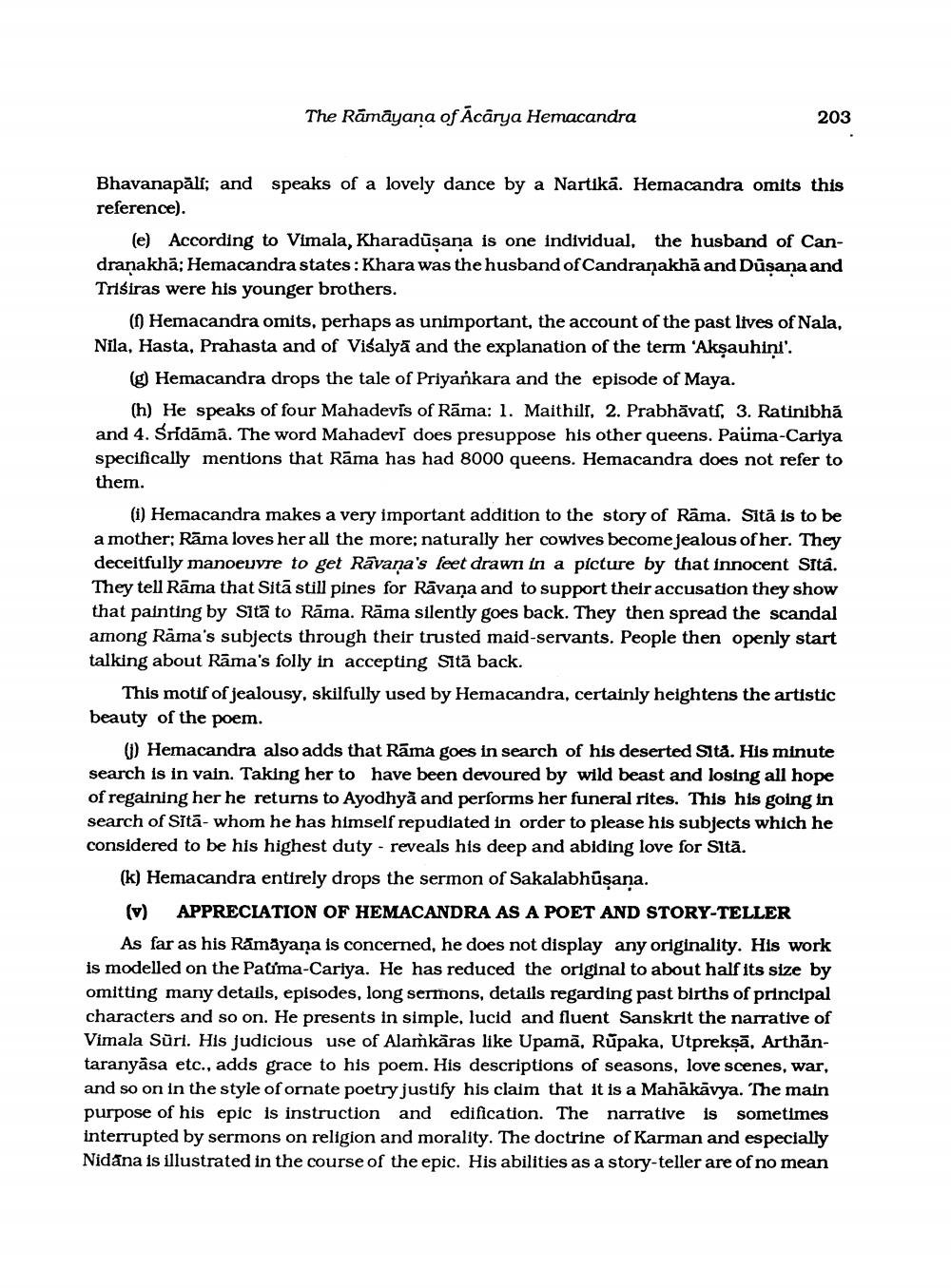________________
The Rāmāyana of Ācārya Hemacandra
203
Bhavanapălf; and speaks of a lovely dance by a Nartikā. Hemacandra omits this reference).
le) According to Vimala, Kharadūsana is one individual, the husband of Candranakhā; Hemacandra states: Khara was the husband of Candranakha and Düşana and Trisiras were his younger brothers.
(1) Hemacandra omits, perhaps as unimportant, the account of the past lives of Nala, Nila, Hasta, Prahasta and of Višalyā and the explanation of the term 'Akşauhiņi'.
(g) Hemacandra drops the tale of Priyankara and the episode of Maya.
(h) He speaks of four Mahadevis of Rāma: 1. Maithill, 2. Prabhāvats, 3. Ratinibhă and 4. Sridāmā. The word Mahadevi does presuppose his other queens. Paüma-Cariya specifically mentions that Rāma has had 8000 queens. Hemacandra does not refer to them.
(i) Hemacandra makes a very important addition to the story of Rama. Sitā is to be a mother; Rāma loves her all the more; naturally her cowives become jealous of her. They deceitfully manoeuvre to get Rāvana's feet drawn in a picture by that innocent Sitá. They tell Rāma that Sitā still pines for Rāvana and to support their accusation they show that painting by Sitā to Rāma. Rāma silently goes back. They then spread the scandal among Räma's subjects through their trusted maid-servants. People then openly start talking about Rāma's folly in accepting Sitā back.
This motif of jealousy, skilfully used by Hemacandra, certainly heightens the artistic beauty of the poem.
() Hemacandra also adds that Rāma goes in search of his deserted Sità. His minute search is in vain. Taking her to have been devoured by wild beast and losing all hope of regaining her he returns to Ayodhya and performs her funeral rites. This his going in search of Sītā- whom he has himself repudiated in order to please his subjects which he considered to be his highest duty - reveals his deep and abiding love for Sitā.
(k) Hemacandra entirely drops the sermon of Sakalabhūşana.
(v) APPRECIATION OF HEMACANDRA AS A POET AND STORY-TELLER
As far as his Rāmāyaṇa is concerned, he does not display any originality. His work is modelled on the Palma-Cariya. He has reduced the original to about half its size by omitting many details, episodes, long sermons, details regarding past births of principal characters and so on. He presents in simple, lucid and fluent Sanskrit the narrative of Vimala Sūri. His judicious use of Alaskäras like Upamā, Rūpaka, Utpreksā, Arthântaranyāsa etc., adds grace to his poem. His descriptions of seasons, love scenes, war, and so on in the style of ornate poetry justify his claim that it is a Mahakāvya. The main purpose of his epic is instruction and edification. The narrative is sometimes interrupted by sermons on religion and morality. The doctrine of Karman and especially Nidana is illustrated in the course of the epic. His abilities as a story-teller are of no mean




